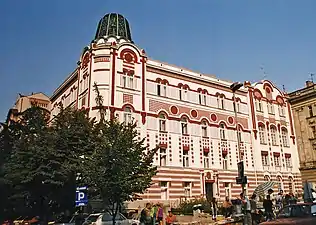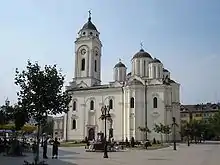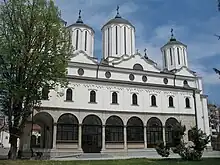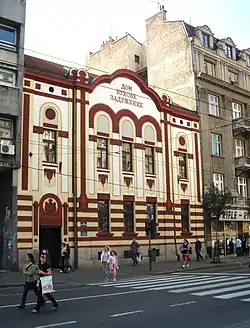
The Modern Serbo-Byzantine architectural style, Neo-Byzantine architectural style or Serbian national architectural style is the style in Serbian architecture which lasted from the second half of the 19th century to the first half of the 20th century. This style originated in the tradition of medieval Serbian-Byzantine school and was part of international Neo-Byzantine style.
History and characteristics


The beginning of the modern Serbian-Byzantine style lies in the romantic spirit, which was prevalent in Europe in the first half of the 19th century, and in the Serbian lands appeared by the mid-century and was alive to its last decades. The beginning of this style can be seen as "resistance" to newcomers' influences of the "western-style" (Classicism, Neo-Baroque) in the Principality of Serbia.[1] The style is characterized by forms and decorations from the Serbian-Byzantine architectural heritage.[1] This architectural approach is not strictly tied to the church architecture; in fact, the style was prosperous in secular architecture. It is also closely linked to the influence of Art Nouveau.[1]
The Modern Serbo-Byzantine architectural style consists of three periods: the first or early period represents a combination of "western-style" with elements of Byzantine architecture. A typical example is the Church of St. George in Smederevo, where the longitudinal basis (characteristic of the West) appears five domes in the form of so-called. "Greek cross". The second period is related to the expansion and strengthening of Serbia, now as a kingdom (1882–1914). During this period, the style is "determined". Numbers of churches are being built, rarely other forms of construction. Examples outside the territory of the Kingdom of Serbia are rare. The third and final period is related to the time between the two world wars, when there was a sudden expansion of the style across the whole of the Kingdom of Serbs, Croats and Slovenes, later Yugoslavia, although its presence was much more dominant in the east, "Serbian" (mostly Central Serbia) part of the work of the Kingdom. Examples of the western part of the Kingdom of Yugoslavia are rare and are mainly related to specific examples of church architecture of the Serbian Orthodox Church. In addition, there are examples related to the Serbs in the diaspora, like the Church of St. Spyridon in Trieste, designed by Carlo Maciachini. Buildings in this period are equally religious and secular.
The Second World War and after was a turning point; after the war with the advent of communism, all forms of historicism in Serbian architecture are discarded, including Serbo-Byzantine style.[1] After the fall of socialist Yugoslavia, Serbo-Byzantine style returned through the construction of new religious buildings such as churches and monasteries.
Architects
Prominent architects of this style are (ordered by the time in which they were active):
- Jan Nevole
- Andreja Damjanović
- Aleksandar Deroko
- Momir Korunović
- Svetozar Ivačković
- Vladimir Nikolić
- Jovan Ilkić
- Dušan Živanović
- Andra Stevanović
- Branko Tanazević
- Petar Popović
- Jovan Novaković
- Dragutin Maslać
- Dragutin Inkiostri Medenjak
- Vasilije Androsov
- Grigorije Samojlov
- Brothers Krstić
Examples
.jpg.webp)



Early period (around 1850-1880)
- Cathedral of Saint George in Smederevo by Andrey Damyanov
- Serbian Orthodox Cathedral in Niš by Andrey Damyanov
- Serbian Orthodox Cathedral in Vranje by Andrey Damyanov
- Serbian Orthodox Cathedral in Sarajevo by Andrey Damyanov
- Cathedral of the Holy Trinity in Mostar by Andrey Damyanov
- Church of the Ascension in Belgrade by Pavle Stanišić and Jovan Ristić
Middle period (1880-1914)
- Saint Spyridon Church in Trieste by Carlo Maciachini
- Old church in Pančevo by Svetozar Ivačković
- Church of St. Elias in Leskovac by Svetozar Ivačković
- Church at the New Cemetery in Belgrade by Svetozar Ivačković
- Saint Peter's Church in Jagodina by Svetozar Ivačković
- The chapel at the cemetery in Sremski Karlovci by Vladimir Nikolić
- Holy Trinity Church in Paraćin by Jovan Ilkić
- Saint George's church in Kruševac by Dušan Živanović
- Church of St. Archangel Michael in Herceg Novi
- St. Sava Church in Kosovska Mitrovica by Andra Stevanović
- St George's Church in Oplenac by Andra Stevanović
- The building of the old telephone exchange in Belgrade by Branko Tanazević
- Home of Vuk's Foundation in Belograde by Branko Tanazević
- District offices in Vranje by Petar Popović
Late period (1914-1941)
- Grammar school in Čačak by Dragutin Maslać
- Grammar school in Sremska Mitrovica by Momir Korunović
- Church of the Ascension of Christ in Krupanj by Momir Korunović
- Ministry of Post in Belgrade by Momir Korunović
- Sokol home in Bijeljina by Momir Korunović
- Old Post Office in Belgrade by Momir Korunović
- Cathedral of Christ the Saviour in Banja Luka by Dušan Živanović
- Church of Saint Sava by Bogdan Nesterović and Aleksandar Deroko
- White Palace in Dedinje, Belgrade by Živojin Nikolić, Viktor Lukomski and Nikolay Krasnov
- House of Elezović in Belgrade by Aleksandar Deroko
- Building of the Patriarchate in Belgrade by Viktor Lukomski
- St. Mark's Church in Belgrade by Branko and Petar Krstić
- Church of St. Constantine and Helen in Požega by Vasilij Adrosov
- Sokol home in Sombor by J. Bazler and V. Sabo
- Banski Dvor in Banja Luka
- The mausoleum in Corfu by Nikolay Krasnov
- Đorđević's House on Topčider in Belgrade by Branislav Kojić
- Hotel in Sopoćani near Novi Pazar by Dragiša Brašovan
See also
References
- 1 2 3 4 Carlton, Richard; Bešo, Smajo, eds. (2019). "Perspectives on cultural heritage loss and reconstruction 20 years after the end of conflict in Bosnia and Herzegovina". Heritage Under Pressure – Threats and Solution: Studies of Agency and Soft Power in the Historic Environment. Oxbow Books. pp. 244–258. ISBN 9781789252477.
Further reading
- Kadijević, Aleksandar (1997). Jedan vek traženja nacionalnog stila u srpskoj arhitekturi: sredina XIX-sredina XX veka [One Century of Searching for a National Style in Serbian Architecture, midnineteenth – midtwentieth century]. Građevinska knjiga. ISBN 978-8-6395-0339-0.
